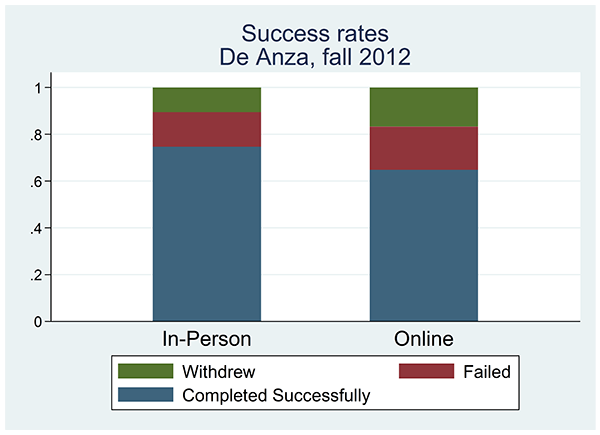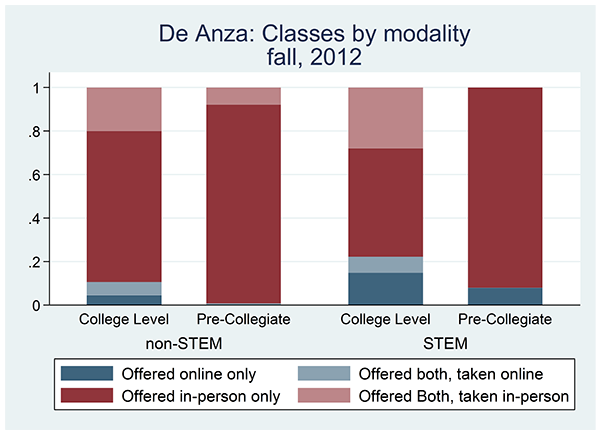De Anza Community College has longstanding experience in delivering online classes, which provides a unique opportunity to study the greatest strengths and challenges in online education today. Such research can help support effective online learning at De Anza and beyond, as online education undergoes unprecedented expansion at the state and national levels. In this document, we summarize the initial work of a research partnership between De Anza Community College and the Stanford University Graduate School of Education, formed to examine what predicts success in online courses, and whether there are early warning signs that could trigger extra supports to help students succeed.
In our preliminary analyses, we find that online learners are more likely than in-person learners to fail or drop out of a class (below figure). On its surface, this finding casts doubt on the potential for online education to improve college access, expand educational flexibility, and contain rising college costs.

However, it is possible that the kinds of classes offered online, as opposed to the online format itself, explains poorer online performance at De Anza. For example, if particularly difficult courses are offered online, this difficulty (as opposed to the online format itself) could account for poorer outcomes. In support of this possibility, we find there is no overlap between the five largest-enrollment departments and the five largest-online-enrollment departments at De Anza, and college-level and STEM (science, technology, engineering, and mathematics) sections—which may be particularly challenging—are more often taken online than pre-collegiate and non-STEM sections (below figure)

Another explanation for why online learners succeed less than in-person learners could be that different kinds of students are drawn or driven to online learning. For example, if students who choose the flexibility of an online format are more often balancing their coursework with employment or parenting, it may be these conflicting demands, as opposed to the online format itself, that hinder performance. In support of this possibility, we find that students who choose to take a class online when it is offered both online and in-person are even less likely to succeed than students enrolled in classes only offered online. Additionally, we observe demographic differences in who is more likely to choose online classes: Asians and Whites are more likely to take classes only offered online, and Latinos are more likely to take classes only offered in-person, but when given the choice, Asian and White students lean slightly towards in-person learning while Latinos (along with Blacks and Filipinos) lean slightly towards online learning. This aligns with the argument that different kinds of students may choose to study online.
To take multiple factors into account simultaneously, we ran regressions predicting the likelihood that subgroups of students (e.g., by gender or race/ethnicity) would withdraw from a course, or if they did not withdraw, the likelihood they would pass. Among other interesting outcomes, we find that the higher the percentage of classes a student takes online, the less likely he is to pass an online class (though their probability of passing an in-person class does not similarly decrease). We also find interesting variations by gender and race/ethnicity, e.g., Filipino students are more likely than White students to withdraw from an online class, but they are no more likely than White students to withdraw from an in-person class. These preliminary findings are described and discussed in detail below.